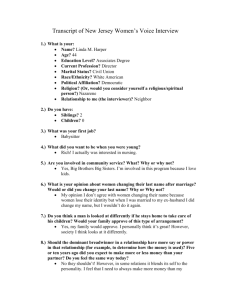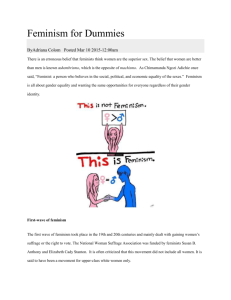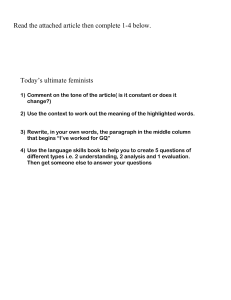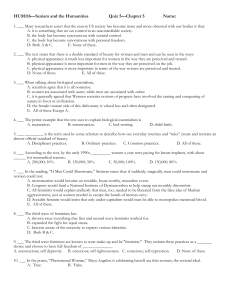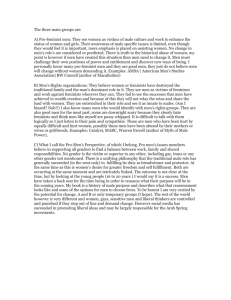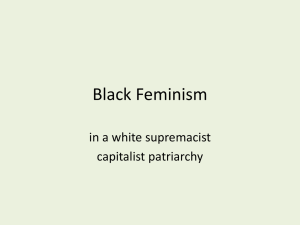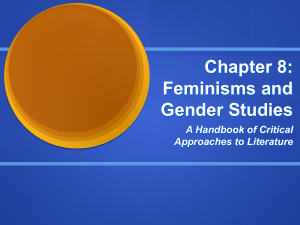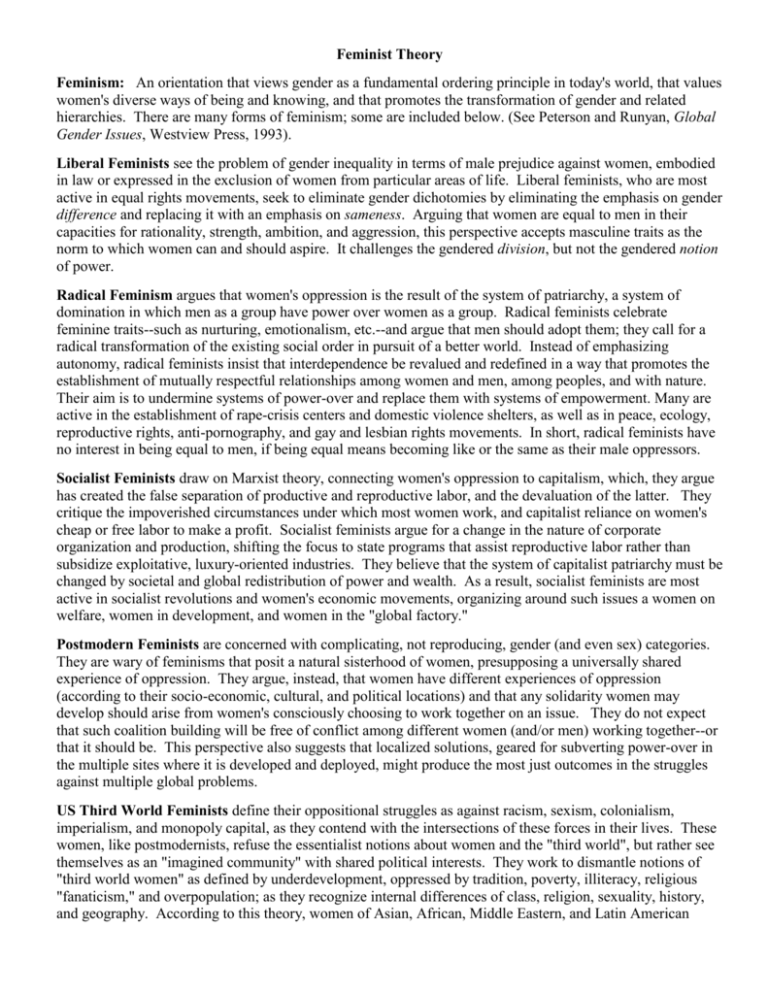
Feminist Theory
Feminism: An orientation that views gender as a fundamental ordering principle in today's world, that values
women's diverse ways of being and knowing, and that promotes the transformation of gender and related
hierarchies. There are many forms of feminism; some are included below. (See Peterson and Runyan, Global
Gender Issues, Westview Press, 1993).
Liberal Feminists see the problem of gender inequality in terms of male prejudice against women, embodied
in law or expressed in the exclusion of women from particular areas of life. Liberal feminists, who are most
active in equal rights movements, seek to eliminate gender dichotomies by eliminating the emphasis on gender
difference and replacing it with an emphasis on sameness. Arguing that women are equal to men in their
capacities for rationality, strength, ambition, and aggression, this perspective accepts masculine traits as the
norm to which women can and should aspire. It challenges the gendered division, but not the gendered notion
of power.
Radical Feminism argues that women's oppression is the result of the system of patriarchy, a system of
domination in which men as a group have power over women as a group. Radical feminists celebrate
feminine traits--such as nurturing, emotionalism, etc.--and argue that men should adopt them; they call for a
radical transformation of the existing social order in pursuit of a better world. Instead of emphasizing
autonomy, radical feminists insist that interdependence be revalued and redefined in a way that promotes the
establishment of mutually respectful relationships among women and men, among peoples, and with nature.
Their aim is to undermine systems of power-over and replace them with systems of empowerment. Many are
active in the establishment of rape-crisis centers and domestic violence shelters, as well as in peace, ecology,
reproductive rights, anti-pornography, and gay and lesbian rights movements. In short, radical feminists have
no interest in being equal to men, if being equal means becoming like or the same as their male oppressors.
Socialist Feminists draw on Marxist theory, connecting women's oppression to capitalism, which, they argue
has created the false separation of productive and reproductive labor, and the devaluation of the latter. They
critique the impoverished circumstances under which most women work, and capitalist reliance on women's
cheap or free labor to make a profit. Socialist feminists argue for a change in the nature of corporate
organization and production, shifting the focus to state programs that assist reproductive labor rather than
subsidize exploitative, luxury-oriented industries. They believe that the system of capitalist patriarchy must be
changed by societal and global redistribution of power and wealth. As a result, socialist feminists are most
active in socialist revolutions and women's economic movements, organizing around such issues a women on
welfare, women in development, and women in the "global factory."
Postmodern Feminists are concerned with complicating, not reproducing, gender (and even sex) categories.
They are wary of feminisms that posit a natural sisterhood of women, presupposing a universally shared
experience of oppression. They argue, instead, that women have different experiences of oppression
(according to their socio-economic, cultural, and political locations) and that any solidarity women may
develop should arise from women's consciously choosing to work together on an issue. They do not expect
that such coalition building will be free of conflict among different women (and/or men) working together--or
that it should be. This perspective also suggests that localized solutions, geared for subverting power-over in
the multiple sites where it is developed and deployed, might produce the most just outcomes in the struggles
against multiple global problems.
US Third World Feminists define their oppositional struggles as against racism, sexism, colonialism,
imperialism, and monopoly capital, as they contend with the intersections of these forces in their lives. These
women, like postmodernists, refuse the essentialist notions about women and the "third world", but rather see
themselves as an "imagined community" with shared political interests. They work to dismantle notions of
"third world women" as defined by underdevelopment, oppressed by tradition, poverty, illiteracy, religious
"fanaticism," and overpopulation; as they recognize internal differences of class, religion, sexuality, history,
and geography. According to this theory, women of Asian, African, Middle Eastern, and Latin American
countries and of the diasporas, as well as American Indians, share a common context of struggle against
multiple exploitative structures and systems. (See Third World Women and the Politics of Feminism, eds.
Mohanty, Russo, Torres. Indiana UP, 1991).
Transnational Feminism emerged in the 1990's and is concerned with contemporary global conditions, at the
intersections of feminism, colonialism and postcolonial discourses, modernism and postmodern hybridity.
Like US Third world feminists, they bridge feminist left ideology (socialism) and postmodernism, while
working for transnational feminist alliances, as they critique feminism's failure to address western modernity
and its hegemonic practices. Transnational feminists argue that feminists need to understand the material
conditions that structure women's lives in diverse locations, particularly in a world structured by transnational
economic links and cultural asymmetries (See Kaplan & Grewal, Scattered Hegemonies).
Ecofeminists see the key to confronting systemic forces that destroy the environment is questioning the
treatment of both women and nature as resources to be used and abused by men and industries. From this
ecofeminist perspective, if patriarchy, capitalism, racism, industrial development, and militarism are the
sources of environmental degradation, women are the solution to it. Rather than questioning gender
stereotypes that associate women with nature, most ecofeminists insist that women are closer to nature
because of the reproductive and productive work they do and, thus, are in the best position to care for the
environment.
Queer theory began as a branch of philosophical investigations of what is known as third wave feminism and
gay and lesbian studies. However, in the last 15 years, the term has taken shape as a new branch of thought
that is suffused throughout the disciplines. Queer theory’s main project is exploring the contestations of the
categorization of gender and sexuality. What is a homosexual? How is the lived experience of a black British
lesbian different from that of a South Asian gay man and how do the experiences relate? How do we
constitute what defines a man? Can a woman be masculine? These are some of the questions asked by queer
theory. Queer Theory is a pairing of words coined by Teresa de Lauretis during a "working conference on
theorizing lesbian and gay sexualities that was held at the University of California, Santa Cruz in February
1990." Around this time Judith Butler published Gender Trouble, Eve Kosofsky Sedgwick published
Epistemology of the Closet, David Halperin published One Hundred Years of Homosexuality, and countless
others went to work on this new area of thought. The beginning debates sometimes focused on social
constructionist vs. essentialist ideologies. That is, are the categories of sexuality socially contrived, created
through discourse, or are they natural givens, outside of our control to make or change? (see wikipedia).
Third-wave feminism is a term identified with several diverse strains of feminist activity and study beginning
in the late 1980s. The movement arose as a response both to perceived failures of second-wave feminism and
to the popular backlash against the progress of that same second wave. Third-wave feminism seeks to
challenge or avoid the second wave's "essentialist" definitions of femininity, which often assumed a universal
female identity and over-emphasized the experiences of upper middle class white women. A post-structuralist
interpretation of gender and sexuality is central to much of the third wave and helps to account for its
heightened emphasis on the discursive power and fundamental ambiguity inherent in all gender terms and
categories. Third wave theory usually encompasses queer theory, women-of-color consciousness, postcolonial theory, critical theory, transnationalism, ecofeminism, and new feminist theory. In contrast to their
predecessors, third wave feminists often focus on "micropolitics," writing about forms of gender expression
and representation that are less explicitly political. They also challenged the second wave's definitions about
what is or is not good for females, by finding signs of empowerment and resistance in areas that were not a
part of the second wave paradigm. Rebecca Walker coined the term “third-wave.”(see wikipedia)
Other Key Terms and Concepts
Socially Constructed Reality: The idea that people's real life experiences are shaped by the meaning
attributed to them through idea systems like language, history, media , education rather than by nature or by
accident.
Essentialism: The limited notion that broad categories such as gender, race or class ascribe common traits or
characteristics to those who are members of that group; these traits are falsely assumed to be part of that
groups "essence" or nature. Essentialism is often contrasted to the concept that reality is socially constructed
and defined by relations of power.
Ideology: A system of beliefs and expectations about human nature and social life that seems to justify the
status quo by "naturalizing" (depoliticizing) existing arrangements.
Gender: The social and political and cultural constructions of the female and males sexes; the idea system
that shapes what we think of as male and female.
Sexuality: Sexual preference (or in psychoanalytic terms, one's "object of desire"), as well as sexual practice.
Sexuality is also socially and culturally constructed. For example, Leila Ahmed questions whether the
"emotional, erotic, and sexual experience within Arab society might be adequately or accurately captured by
such modern Western terms as heterosexual, homosexual, or lesbian." (See Ahmed's Women and Gender in
Islam , Yale UP, 1992).

